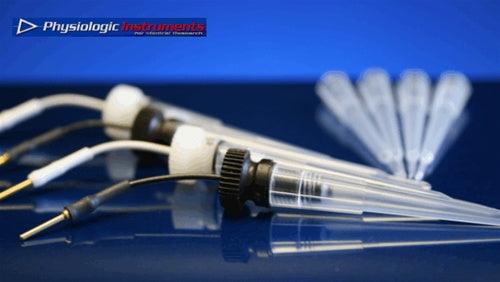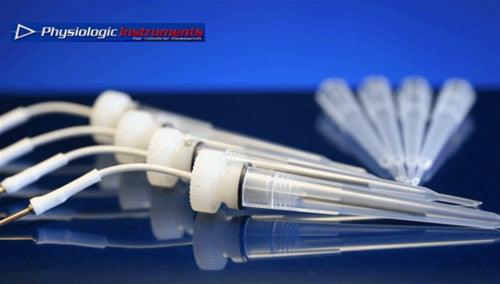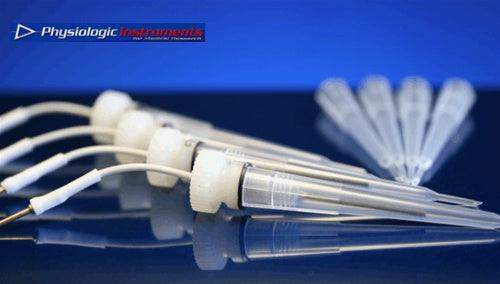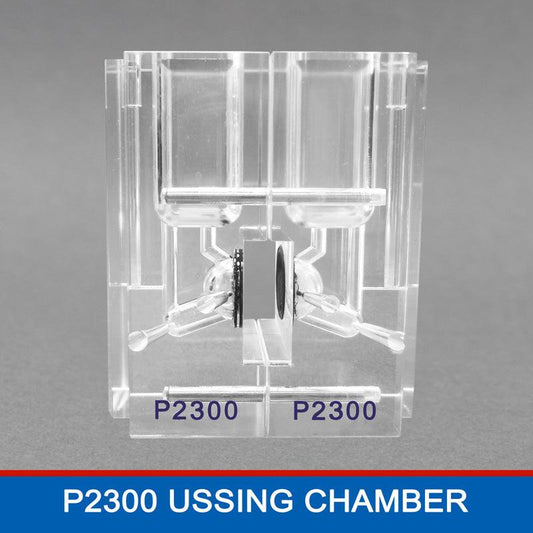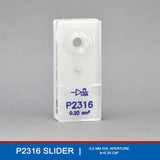P2316 EasyMount Ussing Chamber Slider
The P2316 Ussing Chamber Slider is a specialized 5.0 mm diameter EasyMount Slider (Tissue Holder) engineered for compatibility with the EasyMount Chamber model P2300. This slider features a round aperture designed with a specific groove to securely hold a mounting washer (part number P2316-O), facilitating optimal tissue positioning. With an aperture area of 0.2 cm², the P2316 is ideally suited for the examination of various tissue types, including skin, bladder, and other membranous tissues that can be affixed to a flat washer substrate. This holder is integral to studies requiring precise tissue mounting for electrophysiological or transport studies, offering a stable and consistent interface within Ussing chamber setups.
⦿ To be used with P2300 EasyMount Ussing Chambers- Regular price
- $218.00
- Regular price
-
- Sale price
- $218.00
- Unit price
- per
EasyMount Slider Details

P2316 EasyMount Ussing Chamber Slider for Tissues that may be glued to a flat washer
APETURE SIZE: 5.0MM | Area = 0.2 cm2
The P2316 EasyMount Ussing Chamber Slider is a precision-engineered tissue holder specifically designed for use with the EasyMount Ussing Chamber system (model P2300) in physiological and pharmacological studies. With a diameter of 5.0 mm, this slider features a round aperture with an area of 0.2 cm², making it well-suited for a wide range of tissue samples, including skin, bladder, and other epithelial tissues. The aperture includes an integrated groove to accommodate a compatible mounting washer (part number P2316-O), which facilitates secure attachment of the tissue to the slider.
The design of the P2316 slider is optimized to provide stable positioning for delicate tissue preparations that may require adhesion to a flat washer, ensuring minimal tissue distortion and optimal exposure within the chamber environment. This configuration is especially advantageous in Ussing chamber setups, where precise alignment is critical for measuring tissue transport properties, ion flux, and barrier function under various experimental conditions.
The P2316 slider is thus an essential component for researchers seeking reliable and reproducible tissue mounting in studies that demand meticulous control of experimental parameters. Its compatibility with the P2300 chamber and its robust construction make it a valuable tool in the analysis of physiological responses across different tissue types, providing a high degree of adaptability and consistency in experimental outcomes.
P2316 EasyMount Ussing Chamber Slider Instructions
To utilize the P2316 EasyMount Ussing Chamber Slider in an experiment with the P2300 Ussing Chamber system, follow these detailed steps to properly prepare, mount, and position the tissue for reliable measurements:
1. Prepare the Tissue Sample
- Selection and Handling: Choose an appropriate tissue sample (e.g., skin, bladder, or another membranous tissue) that is well-suited for mounting in an Ussing chamber. Handle the tissue carefully to prevent damage or folding.
- Trimming: Trim the tissue to a size slightly larger than the 0.2 cm² aperture on the slider to ensure full coverage and secure adhesion.
2. Mounting the Tissue on the Washer
- Choose an Adhesive: Select an appropriate, inert adhesive for securing the tissue to the washer (such as medical-grade silicone adhesive or cyanoacrylate-based tissue glue). Ensure that the glue will not interfere with the experimental conditions or react with the tissue.
- Apply the Glue: Carefully apply a thin, even layer of adhesive around the perimeter of the washer (part number P2316-O), avoiding any excess glue that could obstruct the aperture. A very thin coat is generally sufficient.
- Position the Tissue: Place the tissue sample flat over the washer aperture, ensuring that it is taut and fully covers the opening. Press the tissue gently onto the washer’s adhesive-coated surface.
- Drying Time: Allow sufficient time for the glue to set, typically a few minutes, depending on the adhesive type. Ensure the tissue is securely bonded to the washer and has no wrinkles or air pockets.
3. Assembling the P2316 Ussing Chamber Slider with the Mounted Tissue
- Inserting the Washer: Once the tissue is adhered, carefully place the washer with the mounted tissue into the groove within the P2316 EasyMount Slider. The groove is designed to hold the washer firmly in place.
- Securing the Assembly: Confirm that the washer is properly seated within the slider and that the tissue is centered and aligned with the slider’s 0.2 cm² aperture.
4. Mounting in the P2300 Ussing Chamber
- Chamber Setup: Prepare the P2300 Ussing Chamber by filling the chamber compartments with the appropriate physiological solution (e.g., Ringer’s solution) on both sides to mimic in vivo conditions. Pre-warm the solution to maintain temperature consistency if necessary.
- Positioning the Slider: Insert the P2316 slider with the mounted tissue into the P2300 Ussing Chamber, ensuring a tight seal around the edges to prevent leakage. The tissue should be positioned so that each side of the tissue faces a different chamber compartment, allowing for dual-sided perfusion.
- Setting Up Electrodes and Sensors: Place electrodes (voltage and current) within each chamber compartment according to the P2300’s specifications. This configuration will allow for electrical potential measurement and ion transport monitoring across the tissue.
5. Running the Experiment
- Baseline Measurements: Before introducing experimental conditions, record baseline electrical parameters such as transepithelial resistance (TER) and short-circuit current (Isc) to confirm tissue viability and stability.
- Experimental Treatments: Introduce experimental treatments, such as pharmacological agents or ion replacements, to the appropriate chamber compartment to study their effects on the tissue’s transport properties.
- Data Collection: Continuously monitor and record the parameters of interest (e.g., TER, Isc, ion flux) throughout the experiment to assess tissue responses.
6. Completing the Experiment and Cleaning
- Data Analysis: After completing the experimental runs, save and analyze the data to interpret physiological responses.
- Disassembly and Cleaning: Carefully remove the P2316 slider from the Ussing chamber, detach the washer, and dispose of or clean the tissue sample as appropriate. Rinse the P2316 slider and other chamber components with distilled water, followed by a suitable cleaning solution, to maintain equipment integrity for future use.
Following this protocol ensures that the P2316 EasyMount Ussing Chamber Slider and P2300 Ussing Chamber system are used effectively, providing reliable measurements for studies on epithelial and barrier tissue transport and function.


